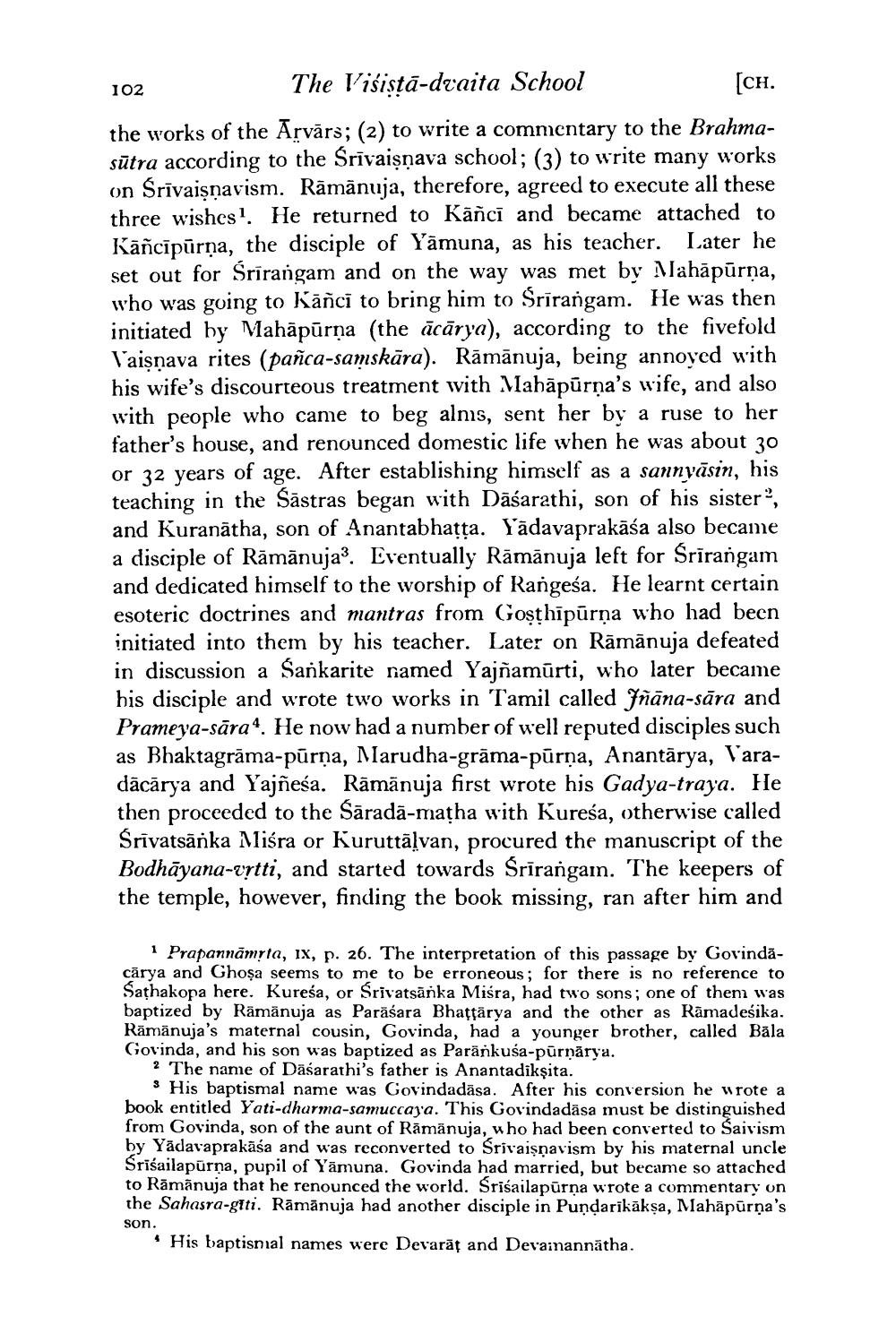________________
102 The l'isista-draita School
[CH. the works of the Arvārs; (2) to write a commentary to the Brahmasūtra according to the Srīvaisnava school; (3) to write many works on Srīvaisnavism. Rāmānuja, therefore, agreed to execute all these three wishes!. He returned to Kāñci and became attached to Kāñcīpūrņa, the disciple of Yāmuna, as his teacher. Later he set out for Srirangam and on the way was met by Alahāpūrna, who was going to Kāñci to bring him to Srirangam. He was then initiated by Mahāpūrņa (the ācārya), according to the fivefold Vaisnava rites (pañca-samskāra). Rāmānuja, being annoyed with his wife's discourteous treatment with Mahāpūrņa's wife, and also with people who came to beg alms, sent her by a ruse to her father's house, and renounced domestic life when he was about 30 or 32 years of age. After establishing himself as a sannyāsin, his teaching in the Sāstras began with Dāśarathi, son of his sister”, and Kuranātha, son of Anantabhałța. Yādavaprakāśa also became a disciple of Rāmānuja? Eventually Rāmānuja left for Srirangam and dedicated himself to the worship of Rangeśa. He learnt certain esoteric doctrines and mantras from Gosthīpūrņa who had been initiated into them by his teacher. Later on Rāmānuja defeated in discussion a Sankarite named Yajñamūrti, who later became his disciple and wrote two works in Tamil called Jõāna-sāra and Prameya-sāra4. He now had a number of well reputed disciples such as Bhaktagrāma-pūrņa, Marudha-grāma-pūrņa, Anantārya, Varadācārya and Yajñesa. Rāmānuja first wrote his Gadya-traya. He then proceeded to the Sāradā-matha with Kuresa, otherwise called Śrīvatsānka Miśra or Kuruttālvan, procured the manuscript of the Bodhāyana-vrtti, and started towards Srirangam. The keepers of the temple, however, finding the book missing, ran after him and
1 Prapannāmrta, ix, p. 26. The interpretation of this passage by Govindacārya and Ghoşa seems to me to be erroneous; for there is no reference to Sathakopa here. Kureśa, or Srivatsānka Misra, had two sons; one of them was baptized by Rāmānuja as Parāśara Bhattārya and the other as Rāmadesika. Rāmānuja's maternal cousin, Govinda, had a younger brother, called Bāla Govinda, and his son was baptized as Paränkuša-pūrnārya.
2 The name of Dāśarathi's father is Anantadiksita.
3 His baptismal name was Govindadāsa. After his conversion he wrote a book entitled Yati-dharma-samuccaya. This Govindadāsa must be distinguished from Govinda, son of the aunt of Rāmānuja, who had been converted to Saivism by Yādavaprakāśa and was reconverted to Srivaisnavism by his maternal uncle Srisailapürna, pupil of Yamuna. Govinda had married, but became so attached to Rāmānuja that he renounced the world. Srisailapūrna wrote a commentary on the Sahasra-gtti. Rāmānuja had another disciple in Pundarikākşa, Mahāpūrņa's son.
* His baptisnal names were Devarāt and Devamannātha.




